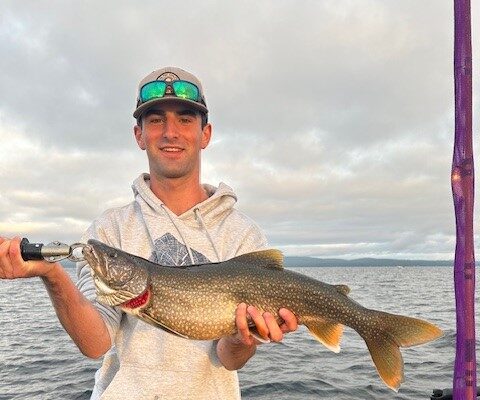
How to catch togue when they’re on the bottom of the lake
By Tom Roth
As the dog days of summer roll in, anglers take to the water in the early morning hours to beat the heat.
The surface temperatures climb, and cold-water fish including lake trout (togue) and salmon generally go deeper. On big lakes like my home base of Sebago, the water at the furthest depth is much cooler. As of today, the temperature in 122 feet of water is a bone-chilling 44 degrees.
How do I know that you ask?
Well, I didn’t dive down with a thermometer. The app, LIVE Datacenter, reports on the research buoy that is set in Lower Bay, recording temperatures every several feet. It also records critical information like dissolved oxygen at each depth. On the top of the lake, the surface temperature is currently 71 degrees.
No wonder why lake trout like to hang out on bottom this time of year.
Now as we enter July and daily temperatures are often above 75 degrees, I along with much of the Sebago angling entourage, fish deep for lakers when surface temperatures soar.
Back when I was a youngster, my dad bought a trolling rod and a big Penn reel and filled it with leadcore line. This was before the popularity of downriggers.
Leadcore line is made up of various colors, each color representing 30-feet of line. Anglers often mention fishing 4 colors, meaning they let out 120 feet of line. With that heavy line, you can get a lure down near the bottom where the big ones live.
We would let out a few colors and try this depth, then let out one more color until we got into the fish. Many times it was salmon that found the preferred temperature at the same depth we were dragging a lure through. If we felt the lure hit bottom, we’d crank up a few turns on the reel and skim bottom, often eliciting a strike by a hungry lake trout. I used, and still use, large “flatfish” lures to bounce the bottom. These lures are responsible for some of the big ones we drag up from the bottom.
As fishing techniques advanced, we bought a small clamp-on downrigger that you had to raise and lower by hand. This worked much better, but your arm grew tired by the end of the day.
When I was older and started fishing more seriously, I invested in electric downriggers. Today, I run state-of-the art downriggers that do more than just bring the offering up and down. I run Humminbird downriggers that have their own transducer that finds the exact depth. The unit is set to run the lure one or two feet above bottom. As the bottom depth changes, the unit reels in or dispenses the downrigger cable, keeping the lure consistently just above bottom.
What an advantage for lake trout anglers!
Whether you use leadcore line, a manual downrigger or something more sophisticated, you need to get your bait or lure into cooler, deeper waters as the summer water temperatures increase.
Big fish await those who play the deep waters as summer heat pushes the fish down in the water column.